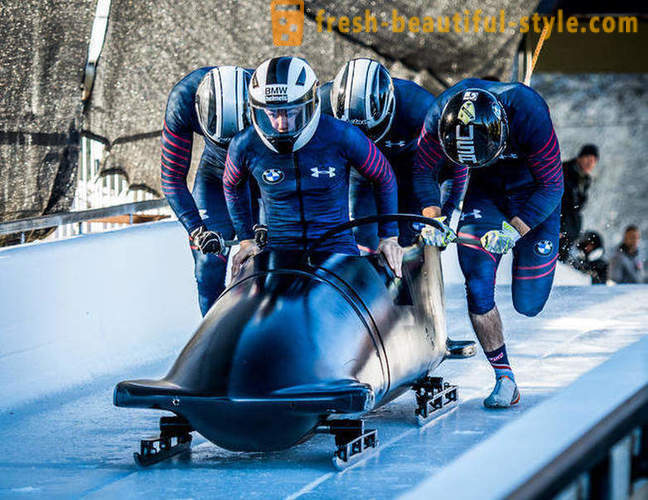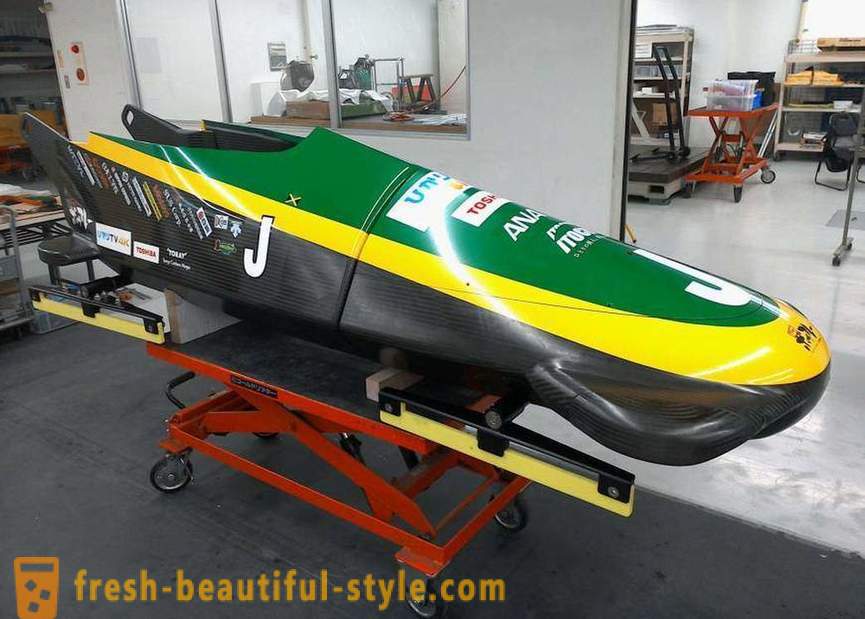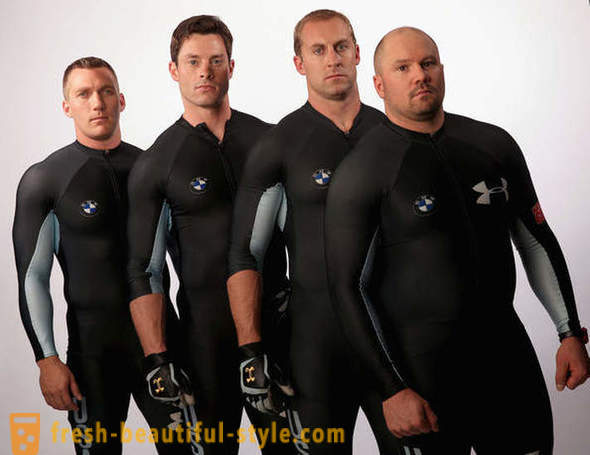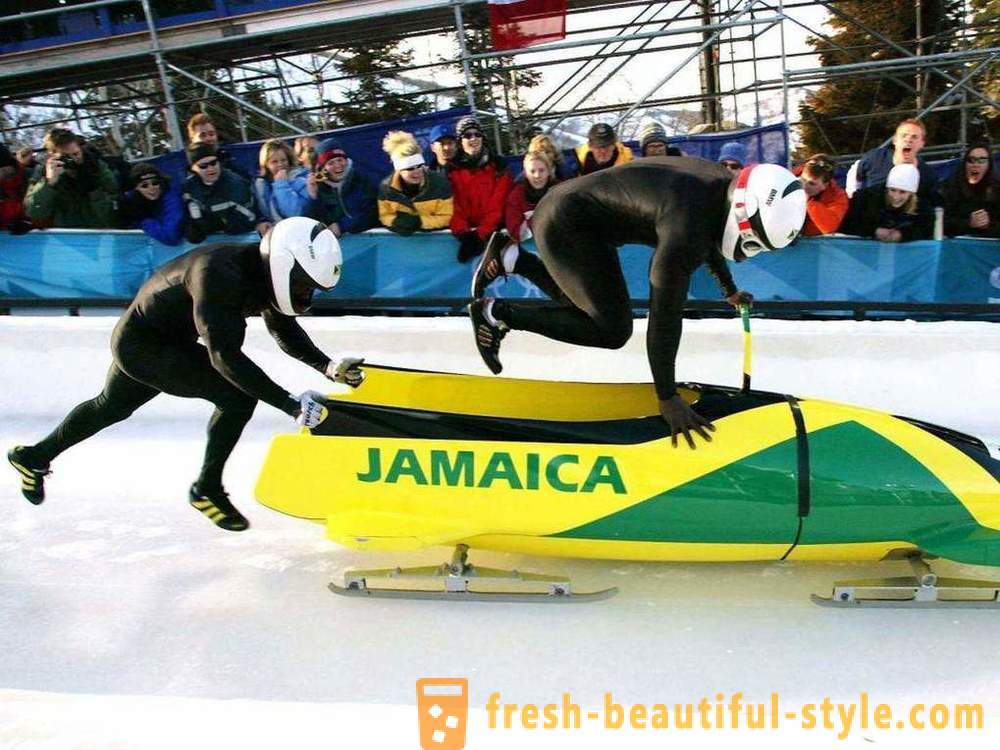Sport bobsleigh history and appearance of the main features
Bobsleigh - winter sport included in the Olympic program. It is a descent on the ice road in the special sledges, called beans. Sani manage a team of athletes, each of which performs specific functions. Ice chute has a plurality of turns and bob speed can reach 150 km / h, so the bob is classified as the most dangerous winter sports.
Below is pictured sport Bobsleigh - Four-crew.

The history of bobsleigh in dates
- 1888. In Switzerland, the Englishman Wilson Smith to move from St. Moritz to Celerina I used combined board sleigh - so was born the idea of bobsleigh.
- 1897. In St. Moritz bobsleigh club was organized on the basis of which sports rules and determined the composition of teams, which originally was supposed to be 5 people have been developed - three men and two women.
- 1903. In St. Moritz built the first bobsleigh track.
- 1904. Designed the world's first wooden sledges - the prototype of modern bean.
- 1908. In Australia, for the first time in the history passed the national championship on bobsled.
- 1923. For the development of the sport of bobsleigh created the International Federation of Bobsleigh and Skeleton.
- 1924. Bobsleigh introduced to the program of the Olympic Winter Games.
- 1927. In St. Moritz hosted the first world championship bobsleigh.
- 1932. Fives sleds are replaced by two and four.
- 1980. The emergence Cup bobsleigh world.
- 1984. At the Olympics in Sarajevo Soviet deuce in the face zintis ekmanis and Vladimir Alexandrov's first time in the history of the national bobsleigh won the bronze medal.
- 1990. In competitions women begin to participate.
- 2002. Women get the right to participate in the Olympic Games.
Bobsleigh standards
There are certain requirements for the production of beans and construction of ice roads. Sani should be made of an all-metal body and have a streamlined shape. They are fixed to the two pairs of runners-skates, the first of which is movable with the steering wheel, and the second fixed brake.

The beans are double (the so-called two-piece crew) and quadruple (four-crews). twos length must not exceed 2, 7 m, and its weight is not more than 165 kg. The total weight of the crew is not more than 200 kg. For the four following parameters: 3, 8 m, 230 kg and 400 kg, respectively. In bobsleigh should be a special outfit: tight aerodynamic suits, helmet, goggles, knee pads, studded shoes. Length bobsled track, is typically 1500-2000 m. The number of bends of different degrees of difficulty varies from 15 to 20 pieces. Modern tracks made of concrete, and the trough of cooling pipes are embedded perimeter supporting the necessary ice temperature.
Description of the sport of bobsleigh
bean crew consists of a pilot and scatter-breykmana (or three accelerated in quadruples). The pilot, who is also the captain of the team, manages the sled with the help of the rotating of the first bridge. Its main task - as precisely as possible to fit into corners without hitting the walls of the chute. When you touch the gutter bean speed is markedly reduced, which affects the outcome of arrival. The tail of the body is decelerating, is responsible for stopping the sled. Brake in the form of a comb is located between the two bridges, and allows you to stop the bean if necessary. In the middle are two fours pusher that provide acceleration at the beginning and at the descent, they are a necessary ballast is shifted by turns in one direction or another. Athletes in this sport like bobsleigh, physically strong and powerful (which is not surprising with the weight of the bean and the extreme forces on the slopes).

The training of athletes are not limited to descent on the ice corridor: cardio-load and weight lifting as part of the training process. Nevertheless, no matter how professional the crew was not very much in the bobsleigh depends on the sled themselves (as in the case of a racing car), so many countries are paying attention not only to the preparation of athletes, but also the quality of the beans. For example, in Germany for the research and development of sophisticated bean stand out decent money, and beans, and components are constantly being improved. Many countries have even hired spies to find out technological innovations and the secret of the success of the competition.
Bobsleigh Rules
Bobsleigh is a team sport, so it is important honed the actions of all participants. Objective and scatter pilot - run at maximum result in movement on bean jump move the sledge as possible to pass the road effectively.

That is a good start in most cases is crucial. The first pilot jumps, the last - the back to accelerate. Each crew has to make 4 descent. The winner is the team that scored the lowest total time on the results of all four races. In case of injury of someone of the crew members in the team can be a substitution. If damaged bean, it can be replaced by other sledge the same kind. Athletes may be subject to disqualification if they are caught on various sporting tricks. For example, for heating the runners to better use additional sliding or gravity to increase the speed of the sled. Also, athletes are required to comply with all safety requirements and does not go to the start without the necessary clothing.
Output
So, bobsledding is a high-speed sport, the key element of which is the team (crew), bean and ice track. The crew consists of two or four athletes, each of which performs a specific function: control, braking, acceleration. Athletes need to be physically strong, hardy, have a sense of balance. And as the most dangerous bobsled sport athletes should be bold and courageous. Beans with improved every year, which directly affects the competitive results. It is the quality and professionalism of the sled athletes depend on the outcome of races. Most often, teams are separated from each other by a few hundredths of a second, and the winner is the one who was able to select the ideal trajectory and whose bean technologically more advanced.













































